Choosing the Best Shade Loving Plants For Your Garden
June 25th, 2021 | Categories
Not all of us have a perfectly south-facing garden that soaks up the sun all day long. And even if you do, other buildings, trees and structures may cause shady areas throughout the day. Some gardens like north or east facing ones have more shade than sun over the entire day, and naturally, sun-loving plants will not thrive in such conditions. However, if you think this resigns you to a boring and lifeless garden, you do not need to fret.
The fantastic news is that there are many plants than can tolerate shade, and many that prefer it, with some still producing lovely colourful flowers – no, really! You can have a garden that is as inviting, interesting and as colourful as any, you just need to know the right plants for your specific situation. So, read this guide to get all the information you need to know when it comes to choosing the best shade loving plants for your garden. You’ll be able to start planning, picking and planting your way to a delightfully inviting space in no time.
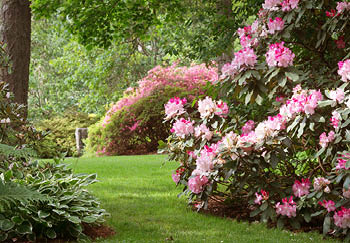
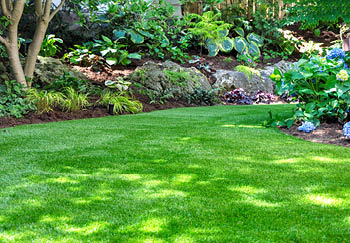
Understanding How Much Shade
The first thing you need to consider and understand is how much shade you have because there are a wide range of specific shade situations, and plants respond differently to different levels of shade. Here are the main types of shade so you can figure out what you have, and it could be a mixture:
Light Shade
Open to the sky but screened from direct sunlight by something such as a structure like a wall or even trees.
Partial Shade
A spot that gets three to six hours of direct sunlight per day but is shaded for the rest of the time.
Dappled Shade
Dappled shade is classed as shade caused by something partially blocking sunlight such as a tree canopy. The light still shines through in a blotchy manner to a lesser degree. Akin to partial shade depending how much light makes it through.
Moderate Shade
A spot that gets two to three hours of direct sunlight per day.
Heavy Shade
A spot that gets less than two hours of direct sun per day, perhaps blocked by a building or dense tree cover.
Important note – if during these time frames you get the sun during the midday hours, this actually applies more direct light, and might upgrade your shade category. For example, you might think you have moderate shade because you only get up to three hours of direct sunlight per day, but if these hours of sun occur around midday when the sun is at its highest, then you would say it’s actually a partially shaded area. Now you should be able to work out what category of shade you have more easily.
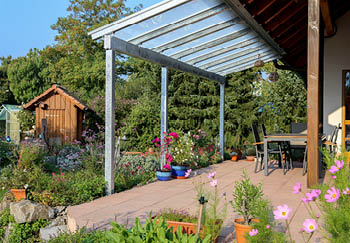
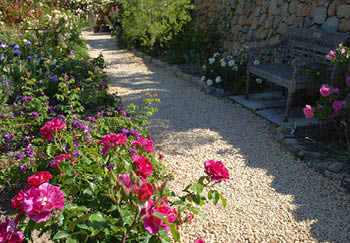
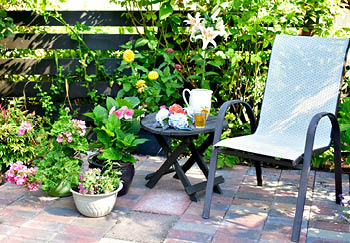
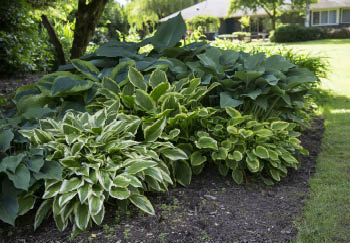
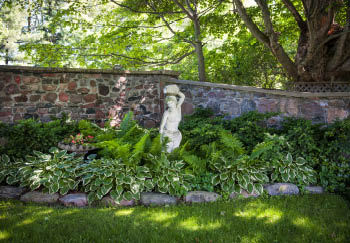
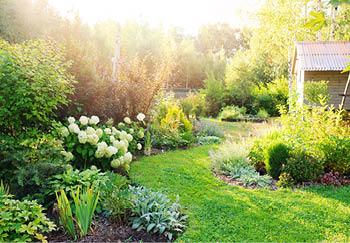
Consider Your Soil Too
It’s important to consider your soil in the shaded areas too. Shaded areas are known to come with very damp and soggy, or very dry soil. If your soil happens to be dry, then the best thing for you to do prior to planting anything is to improve it. You can do this by digging it up, and then digging in plenty of good compost, as well a drainage improver like Perlite. This is even more essential if you have a heavy clay soil.
Afterwards, it’s also advisable to apply an organic mulch over the top of the planting area and around the base of your plants each year in spring. This will break down and improve the soil further. If it’s the opposite and happens to be wet, then you do exactly the same thing. Though perhaps more emphasis will have to be placed on the drainage improver in wet cases. Sorted.
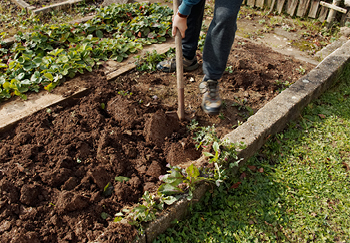
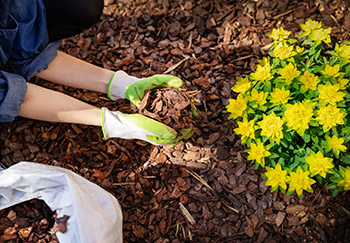
Shade Loving Plant Ideas in Your Garden
Now you know the different shade and soil considerations it’s time for the good part of this guide: the plant ideas! You might be surprised at just how much choice you have available.
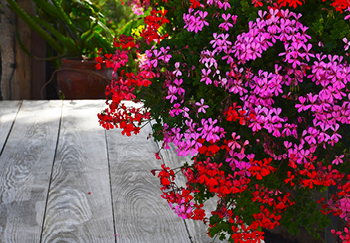
Perennial Flowering Plants
These shade tolerant flowers can be planted once and will come back with lovely flowers year after year so long as you look after them. So, here’s a plethora of options for you to consider:
Campanula
Bellflowers thrive in most shade and are lovely little plants producing delicate, purple-coloured bell-shaped flowers during summer through to autumn. They are great for planting in borders.
Dicentra Bleeding Hearts
Bleeding hearts just plain look great, and they are well suited to light shade. The plant produces lovely pink-red heart shaped flowers with white tips. It is a real eye catcher. Plant in front of greener foliage or amongst less colourful shrubs to create interest and make them pop even more.
Hardy Geraniums
A type of geranium, this hardy plant is great for ground cover and will produce lovely, delicate purple flowers with little yellow centres atop tall stems throughout the warmer months. Many geraniums generally are suited to deep shade. It’s a vigorous grower and is particularly good for supressing weeds.
Forget-Me-Nots
These popular plants can grow to be roughly two feet high, with lovely five-petaled blue flowers in the warmer weather. It grows best from moderate to heavy shade and doesn’t require much attention but watch out for it spreading ever outwards.
Foxglove
Foxgloves are a great choice because they will grow tall slender stems creating great vertical interest with their lovely tube-shaped flowers that can be white, pink, yellow, red, purple or lavender in colour. They are best for light to dappled shade.
Aquilegia
So called for their bonnet shaped flowers, these have been popular for generations, producing lovely bobbing purple-blue flowers above a heap of foliage. They are better suited from light to partial shade. Suitable up to partial shade.
Geraniums
Not necessarily a specific plant, but Geraniums are worth mentioning because they do quite well in shade generally and come in a diverse range of colours, opening your choices up even more.
Hellebores
A little different from the others because this is a winter-flowering plant that also happens to do quite well in light to partial shade. Their cup shaped flowers appear in large clusters, and come in a variety of colours from pinks, purples, yellows, and whites.
Rhododendron
An extremely well regarded and popular, delicate little plant, the Himalayan Blue Poppy does well in light to partial shade producing lovely bowl-shaped blue flowers with yellow centres on a leafy stem, that can grow up to one metre tall.
Hydrangeas
Like Geraniums, Hydrangeas do well in shade generally up to partial or light-dappled shade. They bloom with large snowballs of flowers that draw the eye and come in a variety of colours from blues, purples, pinks, reds, and whites. A favourite among gardeners the world over.
Pulmonaria
While it sounds wholly unappealing, the Lungwort is actually a lovely little plant producing little blueish purple flowers in the warmer months but is known to bloom earlier than other plants. It will do well up to moderate shade. A good border and bed plant that will spread out a bit without overwhelming other plants.
Snowdrops
Snowdrops are tolerant of all levels of shade, but you might find them flowering more with lighter levels. These lovely little dropping plants come into their own every winter when they will push through the frozen ground to bloom with their white flowers for weeks. A very popular and attractive plant.
Cyclamen
This hardy little plant is great for light to partial and light-dappled shade. It doesn’t grow very tall at all, but it will spread a little, making it perfect planted in borders that amongst shrubs or under trees. The dark green foliage makes the lovely small flowers are shades of white, pink or red and they really stand out. A lovely plant indeed.
Iris Foetidissima
This plant thrives in full shade and has evergreen foliage with dark purple-green flowers. In Autumn it will reveal large seedpods that split open to show rows of orange seeds that stay well into winter.
Winter Aconites
These lovely plants grow in clumps with deep green leaves and producing bright yellow flowers from late January. They thrive particularly in damp soil with light to moderate shade.
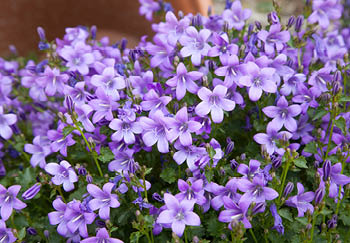
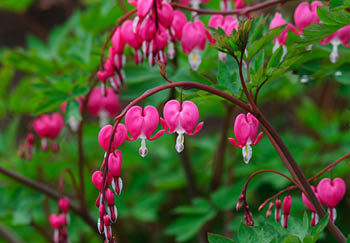

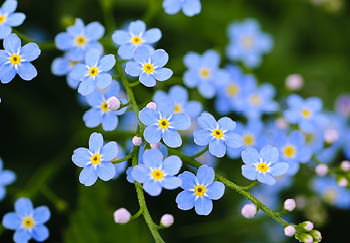




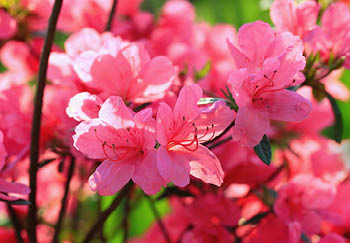

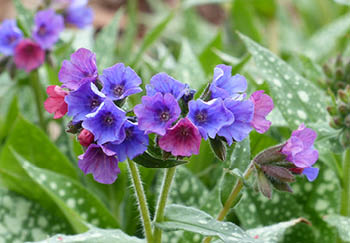
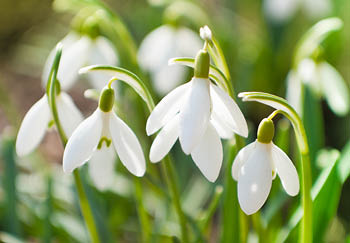
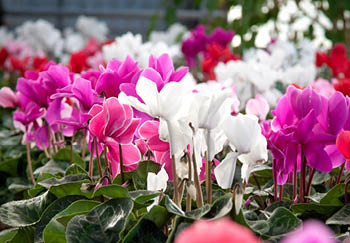

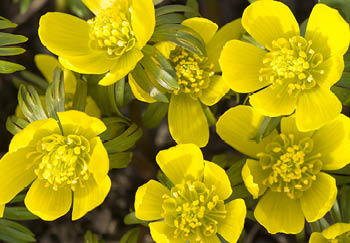
Annual Flowering Plants
Unlike perennials, annuals don’t come back year after year. However, many pack a real punch when it comes to adding colour:
Sweet Alyssum
Alyssum are great little plants for providing an effective ‘carpet’ of colour – whites, purples and pinks – across a bed or border to create separation or even a boundary edge.
Nemophila Menziesii
A lovely little bushy plant producing bright blue bowl-shaped flowers with a white centre. They do well up to partial shade.
Begonias
Begonias do well in partial to moderate shade without a lot of direct sunlight which can really stress them out. A small yet versatile plant that produces flowers coloured bright reds, oranges, whites and yellows and shades in between all season long.
Busy Lizzies
A very popular bedding plant that produces great vibrant flowers throughout the warmer months even up to moderate shade, but they’ll also do well in full sun.
Fuchsia
The super popular fuchsia plants are very eye-catching for their droopy downward white, pink or purple flowers that bloom all season long. If you have hummingbirds in your area, they’ll love them! Fuchsias don’t appreciate lots of sunlight so best for partial to moderate shade.
Mimulus Ringens (Monkey Flower)
Monkey Flowers so called for their face-like shaped flowers, this bushy little plant blooms for a long time over the season and is suited for light to partial shade.
Pansies
Everyone loves Pansies for their vibrant colours and cut petals. They bloom well in light to partial shade, or light dappled shade. Too much light and heat can actually stop them from their full flowering potential.
Antirrhinum
So called because the flowers of this plant uniquely open and close like a jaw. They bloom all season long and do well from partial to moderate shade.
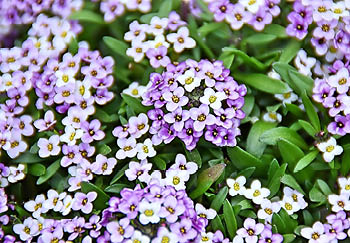
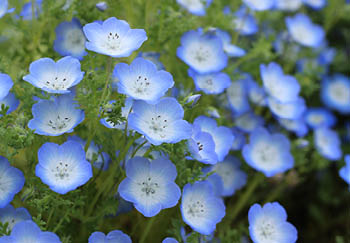

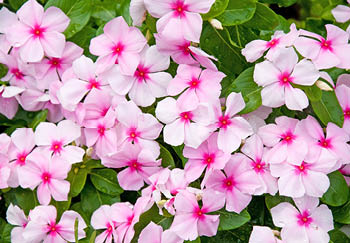
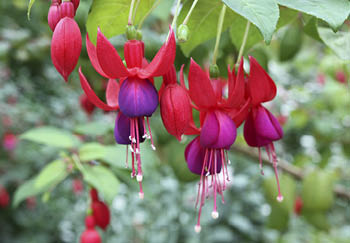
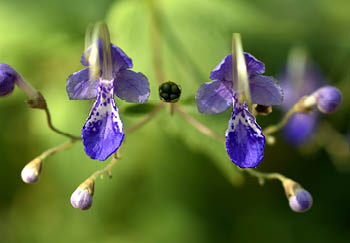
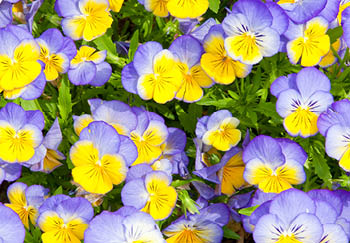
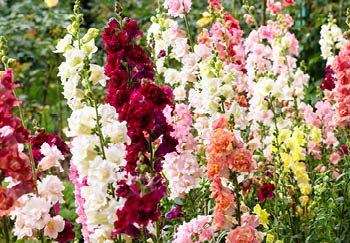
Evergreen Plants
These shade tolerant evergreens will keep their foliage, and some will also change colour or produce flowers when in the spring to autumn:
Buxus Sempervirens
Box, or Buxus sempervirens, is a dense, bushy shrub that’s brilliant for shaping into balls or other shapes. Suited for light to dappled shade.
Heuchera
These will grow in any amount of sunlight/shade and will bloom in the summer. They have many shades of flowers and foliage from orange to yellow to purples and more. Great for adding impact and colour.
Ferns
There are different types of ferns, but they all love light shade and moist soil. They’ll spread out and form a beautiful ground cover. A particularly striking one to look for is the Copper Shield Fern.
Hebe
Hebes are shrubs similar but a great alternative to Buxus that naturally grow in a rounded shape. As an added bonus in the summer, they’ll produce lovely small flowers. However, this is only if they receive enough sunlight, as too much shade will see them grow and become leggy. Light to dappled shade.
Ivy
Ivy plants are great for light all the way to fully shaded spots. They’re a vigorous grower and are particularly good for planting under trees. They will climb or spread, or both given the opportunity. Add extra interest by opting for a variegated leaf variety. Ivy is great for creating a lush background that will allow more colourful plants in front to pop.
Phillyrea
Phillyrea is a hardy little plant that will eventually grow into a large shrub. Similar to the Box and Hebe it can be shaped into hedges or balls or other shapes. Best for light to moderate shade.
Euphorbia
These lovely plants are good in any amount of shade and tolerate a dry spot well. They bear lime-green flowers on top and dark green leaves on the bottom.
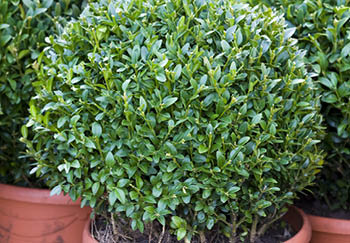
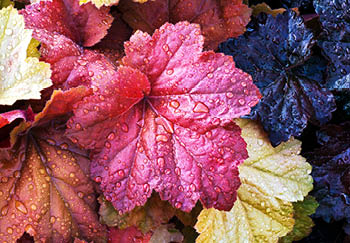

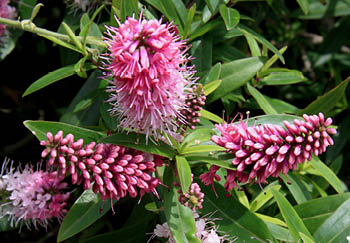
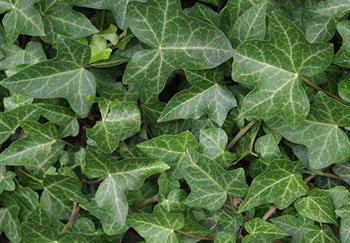
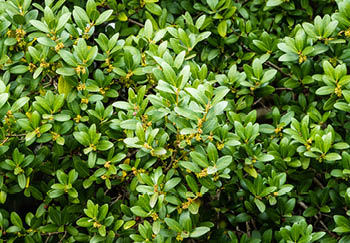

Other Things to Consider
When choosing plants for shade, you also want to consider the hows and whys that go into constructing an impactful display. For instance, you don’t want too many dark greens in an already shaded area, because it will make it look even gloomier. However, use them instead as background and texture. Then plant the ones with more impact and colour in front to make them really pop. Bright and bold colours will work best if you want that maximum impact. Incorporating different leaf shapes such as ferns, hostas and grasses with your flowering plants will help to create texture too. Another thing to note is for any plant that flowers; the heavier the shade the less likely they’ll flower, or not flower as much as in lighter shaded spots. Ultimately all plants need levels of sunlight for the energy to grow and flower (if they do). It’s just something you need to keep in mind.
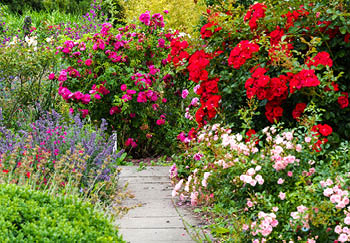
Bring Life to Your Shaded Garden
There you have it. Shade tolerant plants do exist and there’s actually quite a lot of choice. Now that you understand the different types of shade and soil, and which plants you can grow, you can add that colour and vibrancy to an area that otherwise might have gone unloved. We didn’t cover it in this guide, but you can even grow fruit, such as strawberries and gooseberries, as well as herbs like mint and parsley. You can grow vegetables like peas, parsnips, carrots, broccoli, lettuce and even more too. You should have plenty ideas for it now!

Useful Links
- Shop Online for Plants
- How to Start Gardening (Article)
- What to Plant in My Garden (Article)
- Create a Summer Flower Border (Article)
- Fuchsia Growing Guide (Article)
- Three Seasonal Tips for Healthy Hydrangeas (Article)
- Geranium Growing Guide (Article)






